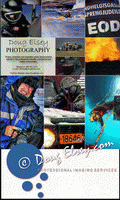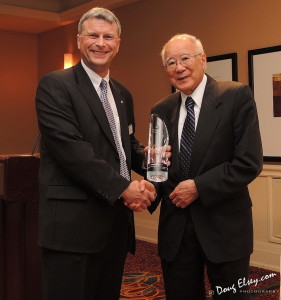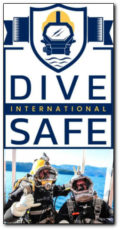Ron Nishi honoured with Technical Excellence Award at Underwater Conference 2014
By CADC Admin ~ May 12th, 2014. Filed under: Latest Diving News.
Ron Nishi – formerly with DRDC Toronto – received the 2014 Technical Excellence Award at the Canadian Underwater Conference and Exhibition in Toronto in April. The following is the text provided by DCBC Chairman Jonathan Chapple on announcing the award …
“Background: The Technical Excellence Award was first awarded at the first Canadian Underwater Conference in 2008. Since then it has been awarded every 2 years, alternating with the Lifetime Achievement Award. Both awards are intended to recognize and honour individuals whose dedication and accomplishments have significantly contributed to the Canadian underwater industry. The previous Technical Excellence award winners are Phil Nuytten (2008), David Fullerton (2009) and James MacFarlane (2011).
Before I start I wish to acknowledge the inputs received from some of Ron’s former colleagues at DRDC in compiling this presentation.
Ron Nishi started his career at the former DCIEM – the Defence & Civil Institute of Environmental Medicine, now DRDC – in Downsview, Toronto, in early 1970. He was an engineering physicist with some experience in acoustics and had been working previously on sonar for the Department of National Defence in Halifax. At DCIEM he soon became involved in the analysis of complex mathematical equations based on the huge amount of data collected during testing of an analogue dive computer (also developed at DCIEM by Kidd and Stubbs). In reviewing the data, he found that
the divers who had been using the computer by following the safe ascent depth generated by the computer had not trusted the computer so they had decided to modify the profile on their own by following the safe ascent depth but staying a foot or two deeper when decompressing. This meant that the original mathematics had to be revised by Stubbs to reflect the divers’ actions. I think that at this point Ron learned a lot about professional divers, in this case Navy divers, and how theory is applied in practice – this knowledge would stand him in good stead in future years.
Ron took on the task of going back to the original dive logs, in which safe ascent depths and actual depths of decompression were written and reviewing all the data. This was a formidable task, especially when you consider there were over 20,000 man hours of dive data. The task was eventually accomplished and after experimental dives designed to test the limits and possibilities of the computer model, Ron produced a new set of modified equations. Further experimental dives using electronic computers enabled him to refine the equations on an ongoing basis.
Using these mathematical equations, he could generate diving tables for a huge spectrum of depth-time profiles, add repetitive dives, and also generate decompression profiles for multi-level dives.
So what was different about this work? There was a common belief that a clear separation existed between safe and unsafe decompression schedules. Ron used decompression stress as a measure of safety in addition to bends or no bends. About that time, US Navy scientists introduced the concept of risk which showed that almost all diving holds some probability of decompression sickness. This concept was explored further by Ron and a DCIEM colleague, working closely with the US Navy scientists. These complex probabilistic decompression theories allow researchers to assess the quality of a decompression model by using statistical techniques – this increases the accuracy of predicting the risk of different dives. We know this now but at the time this was ground-breaking stuff!
Using the desired operational envelope for air diving that the Canadian Forces required, Ron generated and tested the Canadian Forces Air Diving Tables (1983-86) – these have been referenced for many years since then in various diving safety codes across Canada. He developed a simpler version, the DCIEM Sport Diving Tables and also adapted the tables for use with Nitrogen/Oxygen mixtures other than air and finally, developed the Helium/Oxygen HeO2 tables (1986-91). All these tables are in wide use by military and commercial divers worldwide. If you want to get a feeling of how widespread they are I would ask how many in this room alone use or have used the DCIEM tables?
All of this work in decompression would have been seriously hampered without some work done very early in Ron’s tenure at DCIEM. In 1975 he published a paper on the characteristics of sound reflected from bubbles in liquids. This was part of a research program involving the use of Doppler shifts in ultrasound to detect bubbles in the blood as a method of assessing decompression stress. The paper became the definitive reference in subsequent literature. Ron’s continuing work in using decompression bubbles for developing a range of operational diving tables made DCIEM into the world standard for grading bubble sounds.
As a result all the tables generated by DCIEM were extensively tested by manned exposures to the extreme ends of the tables and used ultrasonic Doppler bubble detection methods to test the risk of each exposure. For example nearly 1500 man-dives were done to test the air tables alone. If high levels of bubbles were detected, the given profile was modified and retested. The mathematics was also refined, if necessary, by Ron and his team with each poor score until the mathematical equations developed into a very safe and conservative tool for generating decompression tables. The resulting set of Air, Nitrox and Heliox tables are among the most practical and safest in the world.
On a personal note I had the privilege of being part of Ron’s team at DCIEM during my tour of duty on the UK-Canadian Navy exchange program from 1989-1992. I took part in various HeO2 dive series and believe that I helped to make that model even safer due to the fact that I was a very high bubbler – the bends watch was stood ready very time I went into the chamber! I learned more about diving theory and table development than I thought possible to know and I look back on that period with professional pride and fondness.
Ron retired (if I can use that term) from DRDC Toronto in 2006. His last formal position was as the Senior Scientist in the Canadian Forces Experimental Diving Unit. He worked at DRDC Toronto for over 36 years. However he still keeps his hand in with the staff of the Experimental Diving & Undersea Group in a much-appreciated, informal emeritus status.
As we would expect, Ron has published articles in many scientific journals and presented at numerous conferences over the years. He is recognized in almost every diving medical community and many operational communities. He was a founding member of the Great Lakes Chapter of the Undersea and Hyperbaric Medical Society (UHMS) and served in various executive roles including president. Yet he has maintained an unassuming attitude and has been gracious in emphasizing the role of the team.
In summary Ron has made a significant personal contribution to enhancing the understanding and safety of diving in Canada and worldwide. He is both a pioneer and a key figure in the field of decompression research and has brought international recognition to both himself and to Canada.
Ron, it is my great pleasure, on behalf of the directors of the Diver Certification Board of Canada and the members of this year’s Canadian Underwater Conference organizing committee, to present you with the 2014 Award for Technical Excellence in the diving industry. “
(Editor note: From all of us in the industry Ron, our heartiest in congratulations for a well deserved award in recognition for your significant contributions to the dive industry.)








July 15th, 2015 at 9:48 pm
Well done and well deserved Ron. My most memorable time as Chief Diver in DCIEM /CEDD was working with all of you wonderful folks in the facility from 1980 to 1984.
Congratulations
Best regards,
Milt Skaalrud
C1CD4 Rtd